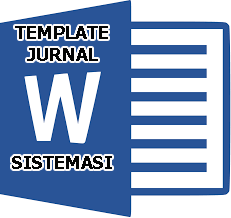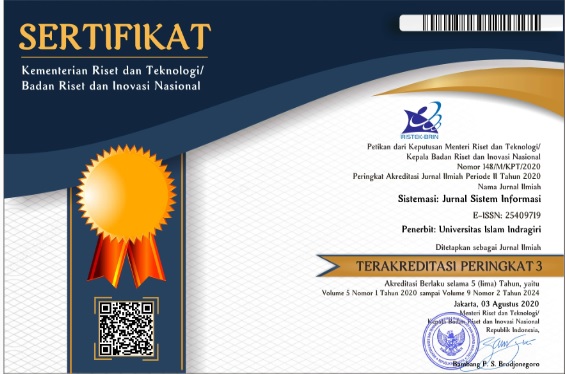User Acceptance Analysis of the BRImo Mbanking Application using the UTAUT and TPB Methods
Abstract
Keywords
Full Text:
PDFReferences
Keisya Salsabila Azahra, “Tinjauan Transformasi Digital Banking Bank Mandiri sebagai Pengembangan Value untuk Nasabah di Era Revolusi Industri 4.0,” Jun. 2023, Accessed: May 03, 2025. [Online]. Available: http://repository.upnvj.ac.id
Z. Y. Pamungkas and A. Sudiarno, “Implementasi Model UTAUT (Unified Theory of Acceptance and Use of Technology) untuk menganalisis Faktor-Faktor yang mempengaruhi Penggunaan Aplikasi Brimo,” Vol. 9, No. 3, pp. 569–578, 2022, doi: 10.25126/jtiik.202296047.
N. S. Elysa, L. Arini, D. F. Murad, and R. Leandros, “User Experience Satisfaction Analysis of Customers on the BRI Mobile Application (BRImo),” in Procedia Computer Science, Elsevier B.V., 2023, pp. 680–689. doi: 10.1016/j.procs.2023.10.572.
M. Abin Prayuda and M. Kadafi, “Analisis Kepuasan Pengguna (Prayuda, dkk.) | 524 Madani,” Jurnal Ilmiah Multidisipline, Vol. 2, No. 6, pp. 524–529, 2024, doi: 10.5281/zenodo.12162455.
L. Priyadi, A. R. Sinaga, and T. Parama Yoga, “Analisis Faktor yang mempengaruhi Intensi dan Perilaku Pengguna BRImo dengan Model UTAUT 2 di Bandung”.
P. H. Nguyen, T. V. Pham, L. A. T. Nguyen, H. A. T. Pham, T. H. T. Nguyen, and T. G. Vu, “Assessing Cybersecurity Risks and Prioritizing Top Strategies in Vietnam’s Finance and Banking System using Strategic Decision-Making Models-based Neutrosophic Sets and Z Number,” Heliyon, Vol. 10, No. 19, Oct. 2024, doi: 10.1016/j.heliyon.2024.e37893.
I. Ajzen, “The theory of planned behavior,” Organ Behav Hum Decis Process, Vol. 50, No. 2, pp. 179–211, 1991, doi: 10.1016/0749-5978(91)90020-T.
A. Habibi, A. Mukminin, A. Octavia, S. Wahyuni, B. K. Danibao, and Y. G. Wibowo, “ChatGPT Acceptance and Use Through UTAUT and TPB: A Big Survey in Five Indonesian Universities,” Social Sciences and Humanities Open, Vol. 10, Jan. 2024, doi: 10.1016/j.ssaho.2024.101136.
J. F. Hair, P. N. Sharma, M. Sarstedt, C. M. Ringle, and B. D. Liengaard, “The Shortcomings of Equal Weights Estimation and the Composite Equivalence Index in PLS-SEM,” Eur J Mark, Vol. 58, No. 13, pp. 30–55, 2024, doi: 10.1108/EJM-04-2023-0307.
V. Venkatesh, J. Y. L. Thong, and X. Xu, “Consumer Acceptance and use of Information Technology: Extending the Unified Theory of Acceptance and use of Technology,” MIS Q, Vol. 36, No. 1, pp. 157–178, 2012, doi: 10.2307/41410412.
H. Joshi, “Integrating Trust and Satisfaction Into the UTAUT Model to Predict Chatbot Adoption – A Comparison Between Gen-Z and Millennials,” International Journal of Information Management Data Insights, Vol. 5, No. 1, Jun. 2025, doi: 10.1016/j.jjimei.2025.100332.
S. P. Sari and S. Cristiana, “Penerapan Model UTAUT (Unified Theory of Acceptance and Use of Technology) terhadap Minat Penggunaan Mobile Banking pada Masa Pandemi berbasis Data Google Trends.” [Online]. Available: https://www.ojk.go.id
M. M. Rana, M. S. Siddiqee, M. N. Sakib, and M. R. Ahamed, “Assessing AI Adoption in Developing Country Academia: A Trust and Privacy-Augmented UTAUT Framework,” Heliyon, Vol. 10, No. 18, Sep. 2024, doi: 10.1016/j.heliyon.2024.e37569.
E. M. Abu-Taieh et al., “Continued Intention to use of M-Banking in Jordan by Integrating UTAUT, TPB, TAM and Service Quality with ML,” Journal of Open Innovation: Technology, Market, and Complexity, Vol. 8, No. 3, Sep. 2022, doi: 10.3390/joitmc8030120.
W. Wei, Y. T. Prasetyo, Z. J. A. Belmonte, M. M. L. Cahigas, R. Nadlifatin, and M. J. J. Gumasing, “Applying the Technology Acceptance Model – Theory of Planned Behavior (TAM-TPB) Model to Study the Acceptance of Building Information Modeling (BIM) in Green Building in China,” Acta Psychol (Amst), Vol. 254, Apr. 2025, doi: 10.1016/j.actpsy.2025.104790.
P. A. Pavlou and M. Fygenson, “Understanding and Predicting Electronic Commerce Adoption: An Extension of the Theory of Planned Behavior,” MIS Q, Vol. 30, No. 1, pp. 115–143, 2006, doi: 10.2307/25148720.
J. F. Hair, G. T. M. Hult, C. M. Ringle, M. Sarstedt, N. P. Danks, and S. Ray, Partial Least Squares Structural Equation Modeling (PLS-SEM) using R. in Classroom Companion: Business. Cham: Springer International Publishing, 2021. doi: 10.1007/978-3-030-80519-7.
J. F. Hair, M. Sarstedt, L. Hopkins, and V. G. Kuppelwieser, “Partial Least Squares Structural Equation Modeling (PLS-SEM): An Emerging Tool in Business Research,” European Business Review, Vol. 26, No. 2, pp. 106–121, 2014, doi: 10.1108/EBR-10-2013-0128/FULL/XML.
M. R. Ab Hamid, W. Sami, and M. H. Mohmad Sidek, “Discriminant Validity Assessment: use of Fornell & Larcker Criterion Versus HTMT Criterion,” in Journal of Physics: Conference Series, Institute of Physics Publishing, Sep. 2017. doi: 10.1088/1742-6596/890/1/012163.
S. Vaithilingam, C. S. Ong, O. I. Moisescu, and M. S. Nair, “Robustness Checks in PLS-SEM: A Review of Recent Practices and Recommendations for Future Applications in Business Research,” J Bus Res, Vol. 173, p. 114465, Feb. 2024, doi: 10.1016/J.JBUSRES.2023.114465.
DOI: https://doi.org/10.32520/stmsi.v14i4.5317
Article Metrics
Abstract view : 395 timesPDF - 92 times
Refbacks
- There are currently no refbacks.

This work is licensed under a Creative Commons Attribution-ShareAlike 4.0 International License.









